Preparation and Properties of Epoxy Composites with Multi-Scale BN Sheets
Abstract
:1. Introduction
2. Materials and Methods
2.1. Materials
2.2. Preparation of Epoxy Resin Composite
2.3. Performance Characterization
- 1.
- Thermal conductivity test
- 2.
- Breakdown performance test
- 3.
- SEM characterization
- 4.
- FT-IR test
- 5.
- Mechanical properties
- 6.
- DC conductivity properties
3. Results and Discussion
3.1. Microstructure Characterization
3.2. Thermal Conductivity
3.3. Breakdown Performance
3.4. DC Conductivity
3.5. Mechanical Property
4. Conclusions
Author Contributions
Funding
Conflicts of Interest
References
- Li, M.H.; Ali, Z.; Wei, X.Z.; Li, L.H.; Song, G.C.; Hou, X.; Do, H.N.; Greer, J.C.; Pan, Z.B.; Lin, C.T.; et al. Stress induced carbon fiber orientation for enhanced thermal conductivity of epoxy composites. Compos. Part B Eng. 2021, 208, 108599. [Google Scholar] [CrossRef]
- Samsudin, S.S.; Majid, M.S.A.; Jamir, M.R.M.; Osman, A.F.; Jaafar, M.; Alshahrani, H.A. Physical, Thermal Transport, and Compressive Properties of Epoxy Composite Filled with Graphitic- and Ceramic-Based Thermally Conductive Nanofillers. Polymers 2022, 14, 1014. [Google Scholar] [CrossRef] [PubMed]
- Wang, Y.; Zeng, Z.; Huang, Z.; Shang, J. Preparation and characteristics of silicone-modified aging-resistant epoxy resin insulation material. J. Mater. Sci. 2022, 57, 3295–3308. [Google Scholar] [CrossRef]
- Wen, R.; Huo, J.; Lv, J.; Liu, Z.; Yu, Y. Effect of silicone resin modification on the performance of epoxy materials for LED encapsulation. J. Mater. Sci. Mater. Electron. 2017, 28, 14522–14535. [Google Scholar] [CrossRef]
- Schab-Balcerzak, E.; Janeczek, H.; Kaczmarczyk, B.; Bednarski, H.; Sęk, D.; Miniewicz, A. Epoxy resin cured with diamine bearing azobenzene group. Polymer 2004, 45, 2483–2493. [Google Scholar] [CrossRef]
- Liu, Z.; Li, J.; Liu, X. Novel Functionalized BN Nanosheets/Epoxy Composites with Advanced Thermal Conductivity and Mechanical Properties. ACS Appl. Mater. Interfaces 2020, 12, 6503–6515. [Google Scholar] [CrossRef]
- Li, S.; Liu, B.; Jia, X.; Xu, M.; Liu, Z.; Liu, G.H.; Huai, X.L. Dopamine-Mediated Bacterial Cellulose/Hexagonal Boron Nitride Composite Films with Enhanced Thermal and Mechanical Performance. Ind. Eng. Chem. Res. 2022, 61, 4601–4611. [Google Scholar] [CrossRef]
- Zhao, J.P.; Ge, D.T.; Zhang, S.L.; Wei, X.L. Studies on Thermal Property of Silica Aerogel/Epoxy Composite. Mater. Sci. Forum 2007, 546, 1581–1584. [Google Scholar] [CrossRef]
- Ganguli, S.; Roy, A.K.; Anderson, D.P. Improved thermal conductivity for chemically functionalized exfoliated graphite/epoxy. Carbon 2008, 46, 806–817. [Google Scholar] [CrossRef]
- Li, Z.; Sheng, G.; Jiang, X.; Tanaka, T. Effects of inorganic fillers on withstanding short-time breakdown and long-time electrical aging of epoxy composites. IEEJ Trans. Electr. Electron. Eng. 2017, 12, S10–S15. [Google Scholar] [CrossRef]
- Sobhani, S.; Jannesari, A.; Bastani, S. Effect of molecular weight and content of PDMS on morphology and properties of silicone-modified epoxy resin. J. Appl. Polym. Sci. 2012, 123, 162–178. [Google Scholar] [CrossRef]
- Liang, M.; Wong, K.L.; Al-gheilani, A. Effect of accelerated aging on the electrical performance of epoxy resin nanocomposite filled with SiO2 nano particles. In Proceedings of the International Symposium on Electrical Insulating Materials (ISEIM), Toyohashi, Japan, 11–15 September 2017; Volume 1, pp. 247–250. [Google Scholar]
- Yang, G.; Zhang, Q.; Wang, D.; Guo, Y.; Li, P. Ability of Impedance on the Electrical Tree of ZnO/Epoxy Composites. High Volt. Eng. 2019, 45, 91–96. [Google Scholar]
- Xu, H.; Xie, C.; Gou, B.; Wang, R.; Li, Y.; Du, Y.; Zhou, J.; Li, L. Synergetic optimization of charge transport and breakdown strength of epoxy nanocomposites: Realizing sandwich topological structure through constructing a SiC@SiO2/EP surface layer and m-BNNS/EP insert layer. Mater. Sci. Semicond. Process. 2022, 141, 106430. [Google Scholar] [CrossRef]
- Lee, S.; Park, D.; Kim, J. 3D-printed surface-modified aluminum nitride reinforced thermally conductive composites with enhanced thermal conductivity and mechanical strength. Polym. Adv. Technol. 2022, 33, 1291–1297. [Google Scholar] [CrossRef]
- Lee, E.S.; Kang, J.G.; Kang, M.K.; Kim, K.H.; Park, S.T.; Kim, Y.S.; Kim, I.; Kim, S.D.; Bae, J.Y. High thermal conductivity of boron nitride filled epoxy composites prepared by tin solder nanoparticle decoration. Compos. Part B Eng. 2021, 225, 109264. [Google Scholar] [CrossRef]
- Yang, F.H.; Sun, X.P.; Zhang, X.; Yao, Z.H. Polyethylene glycol covalently modified the corroded hexagonal boron nitride to improve the thermal conductivity of epoxy composites. Appl. Surf. Sci. 2021, 569, 151094. [Google Scholar] [CrossRef]
- Zhang, Y.; Tuo, R.; Yang, W.; Wu, J.; Zhu, J.; Zhang, C.; Lin, J.; Bian, X. Improved thermal and electrical properties of epoxy resin composites by dopamine and silane coupling agent modified hexagonal BN. Polym. Compos. 2020, 41, 4727–4739. [Google Scholar] [CrossRef]
- Yetgin, H.; Veziroglu, S.; Aktas, O.C.; Yalçinkaya, T. Enhancing thermal conductivity of epoxy with a binary filler system of h-BN platelets and Al2O3 nanoparticles. Int. J. Adhes. Adhes. 2020, 98, 102540. [Google Scholar] [CrossRef]
- Zhou, Z.; Huang, R.; Liu, H.; Zhao, Y.; Miao, Z.; Wu, Z.; Zhao, W.; Huang, C.; Li, L. Dielectric AlN/epoxy and SiC/epoxy composites with enhanced thermal and dynamic mechanical properties at low temperatures. Prog. Nat. Sci. Mater. Int. 2022, in press. [CrossRef]
- Wang, H.; Shin, H. Recent Studies on the Multiscale Models for Predicting Fracture Toughness of Polymer Nanocomposites. Multiscale Sci. Eng. 2022, 1–9. [Google Scholar] [CrossRef]
- Donnay, M.; Tzavalas, S.; Logakis, E. Boron nitride filled epoxy with improved thermal conductivity and dielectric breakdown strength. Compos. Sci. Technol. 2015, 110, 152–158. [Google Scholar] [CrossRef]
- Osanenzadeh, S.G.; Khalid, S.; Cui, Y.; Naguib, H.E. High Thermally Conductive PLA Based Composites with Tailored Hybrid Network of Hexagonal Boron Nitride and Graphene Nanoplatelets. Polym. Compos. 2016, 37, 2196–2205. [Google Scholar] [CrossRef]
- Zhao, T.; Zhang, X. Synergistic Effect of Thermally Conductive Networks in Crystalline Polymer Composites. Polym. Compos. 2018, 39, 1041–1050. [Google Scholar] [CrossRef]
- Fan, B.H.; Liu, Y.; He, D.L.; Bai, J.B. Enhanced thermal conductivity for mesophase pitch-based carbon fiber/modified boron nitride/epoxy composites. Polymer 2017, 122, 71–76. [Google Scholar] [CrossRef]
- Zhou, W.Y. Effect of coupling agents on the thermal conductivity of aluminum particle/epoxy resin composites. J. Mater. Sci. 2011, 46, 3883–3889. [Google Scholar] [CrossRef]
- Liu, C.H.; Huang, H.; Wu, Y.; Fan, S.S. Thermal conductivity improvement of silicone elastomer with carbon nanotube loading. Appl. Phys. Lett. 2004, 84, 4248–4250. [Google Scholar] [CrossRef]
- Choi, J.R.; Rhee, K.Y.; Park, S.J. Influence of electrolessly silver-plated multi-walled carbon nanotubes on thermal conductivity of epoxy matrix nanocomposites. Compos. Part B Eng. 2015, 80, 379–384. [Google Scholar] [CrossRef]
- Artbauer, J. Electric strength of polymers. J. Phys. D Appl. Phys. 1996, 29, 446–456. [Google Scholar] [CrossRef]
- Li, S.T.; Yin, G.L.; Chen, G. Short-term breakdown and long-term failure in nanodielectrics: A review. IEEE Trans. Dielectr. Electr. Insul. 2010, 17, 1523–1535. [Google Scholar] [CrossRef] [Green Version]
- Chen, G.; Davies, A.E. The influence of defects on the short-term breakdown characteristics and long-term dc performance of LDPE insulation. IEEE Trans. Dielectr. Electr. Insul. 2000, 7, 401–407. [Google Scholar] [CrossRef]
- He, L.J.; Zeng, J.J.; Huang, Y.W.; Yang, X.; Li, D.W.; Chen, Y.; Yang, X.Y.; Wang, D.B.; Zhang, Y.X.; Fu, Z.D. Enhanced Thermal Conductivity and Dielectric Properties of h-BN/LDPE Composites. Materials 2020, 13, 4738. [Google Scholar] [CrossRef] [PubMed]
- Somani, P.; Kale, B.B.; Amalnerkar, D.P. Charge transport mechanism and the effect of poling on the current-voltage characteristics of conducting polyaniline–BaTiO3 composites. Synth. Met. 1999, 106, 53–58. [Google Scholar] [CrossRef]
- Manv, A. Theory of transient space charge limited current in solids in the presence of trapping. Phys. Rev. 1962, 126, 1980–1988. [Google Scholar]
- Wang, X.W.; Wu, P.Y. Melamine foam-supported 3D interconnected boron nitride nanosheets network encapsulated in epoxy to achieve significant thermal conductivity enhancement at an ultralow filler loading. Chem. Eng. J. 2018, 348, 723–731. [Google Scholar] [CrossRef]
- Fu, K.; Yang, J.; Cao, C.; Zhai, Q.; Qiao, W.; Qiao, J.; Gao, H.; Zhou, Z.; Ji, J.; Li, M.; et al. Highly multifunctional and thermoconductive performances of densely filled boron nitride nanosheets/epoxy resin bulk composites. ACS Appl. Mater. Interfaces 2021, 13, 2853–2867. [Google Scholar] [CrossRef] [PubMed]
- Li, C.; Bando, Y.; Zhi, C.; Huang, Y.; Golberg, D. Thickness-dependent bending modulus of hexagonal boron nitride nanosheets. Nanotechnology 2009, 20, 385707. [Google Scholar] [CrossRef] [PubMed]
- Lin, Y.; Connell, J.W. Advances in 2D boron nitride nanostructures: Nanosheets, nanoribbons, Nano meshes, and hybrids with graphene. Nanoscale 2012, 4, 6908–6939. [Google Scholar] [CrossRef]
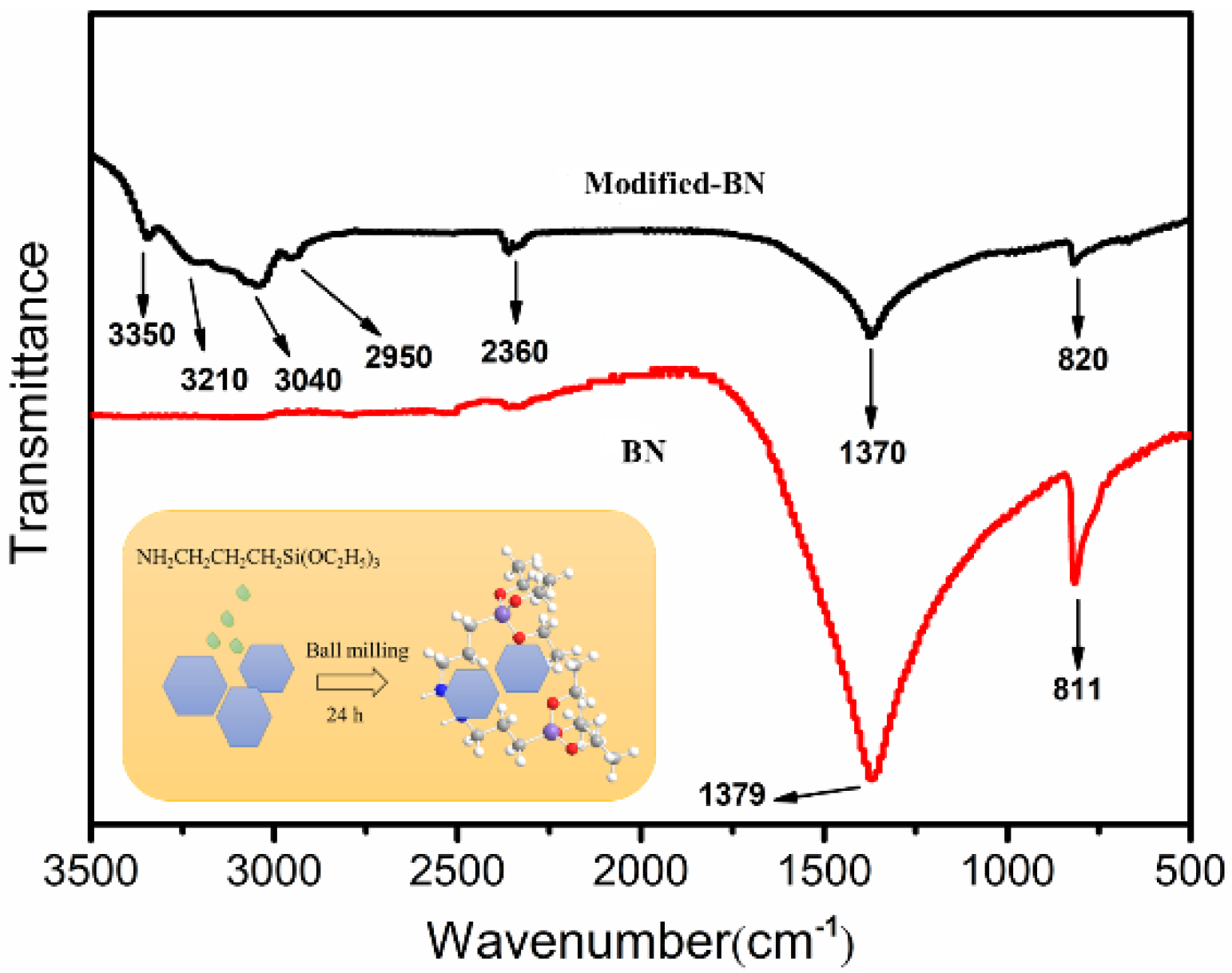
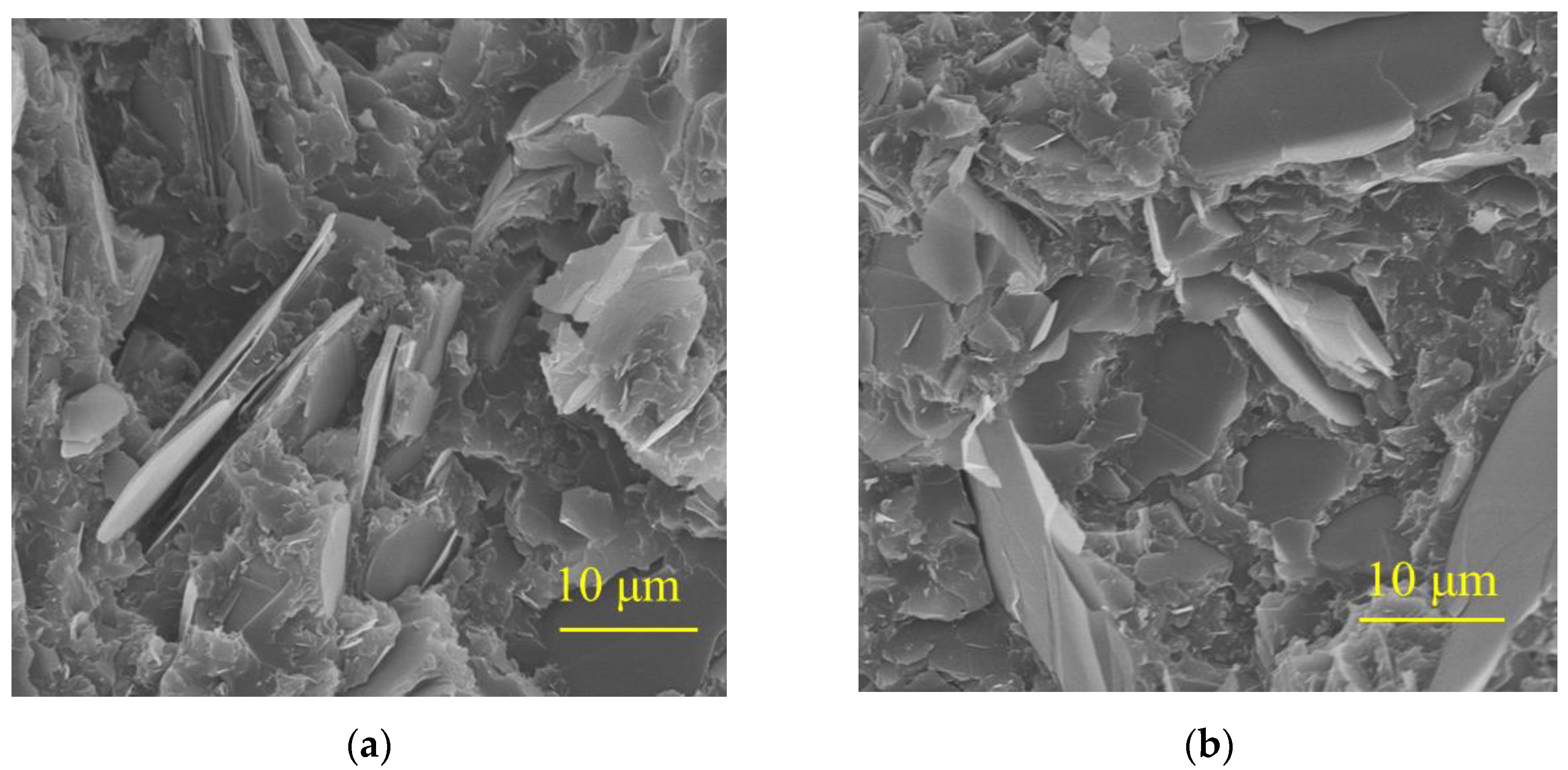
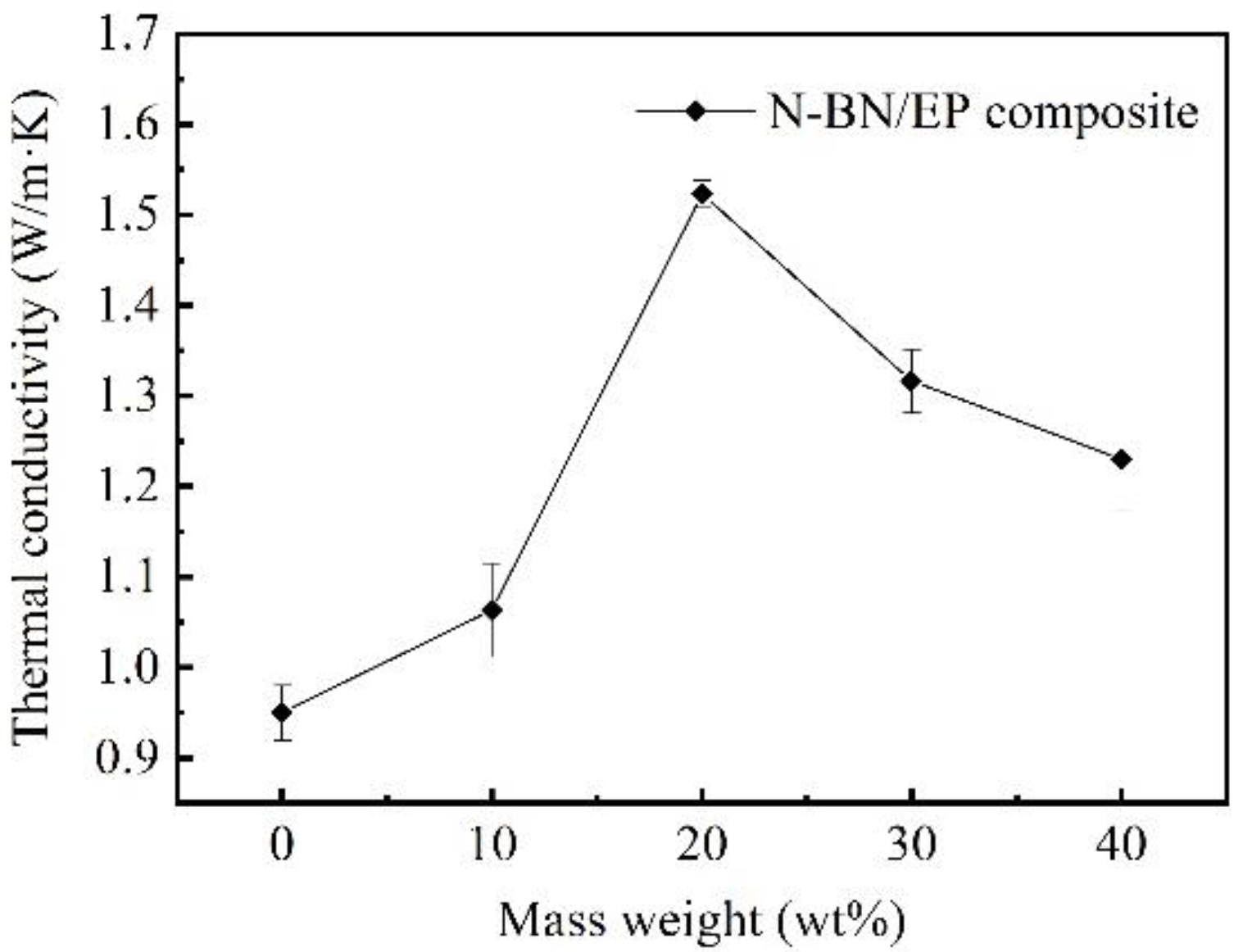
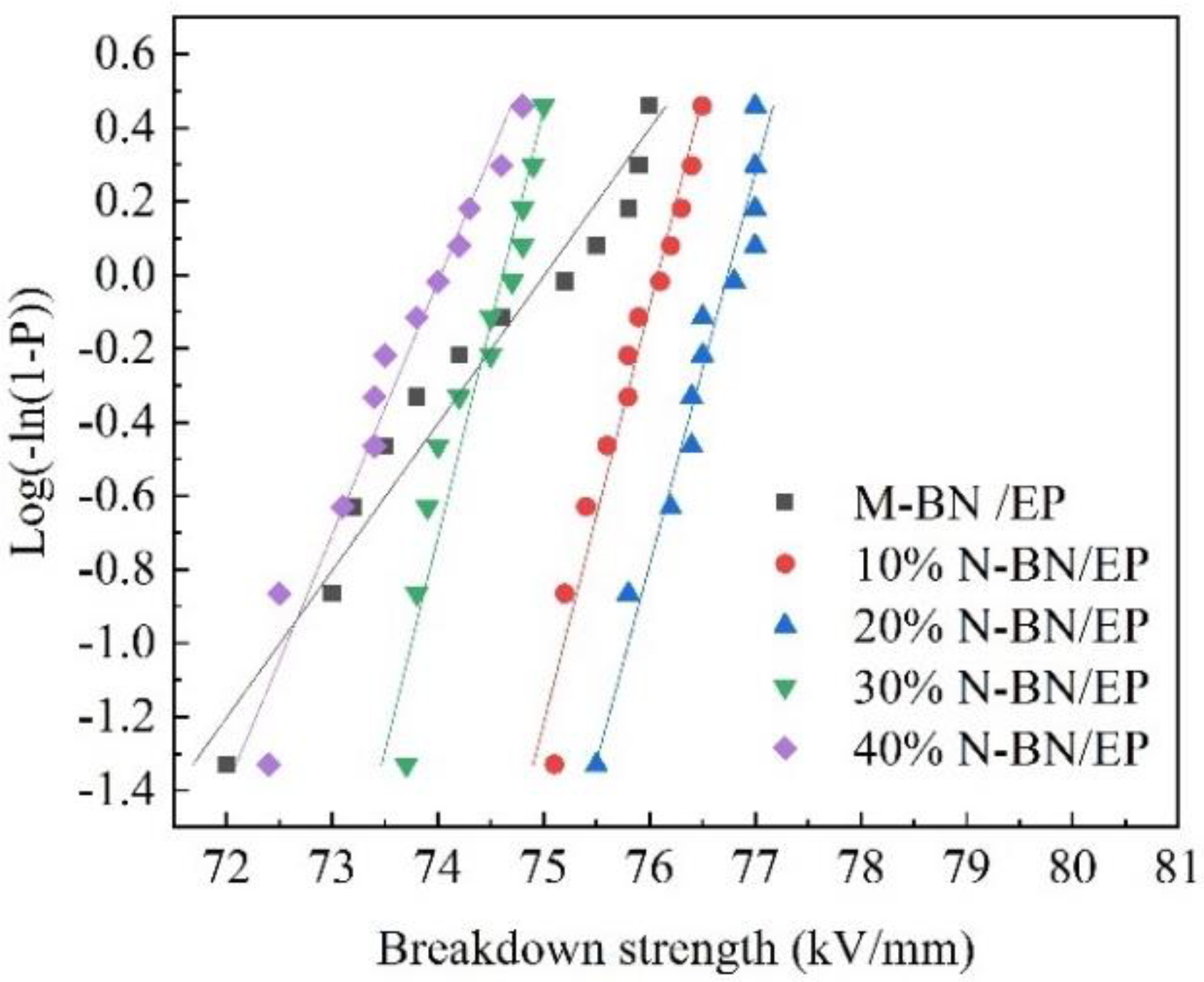
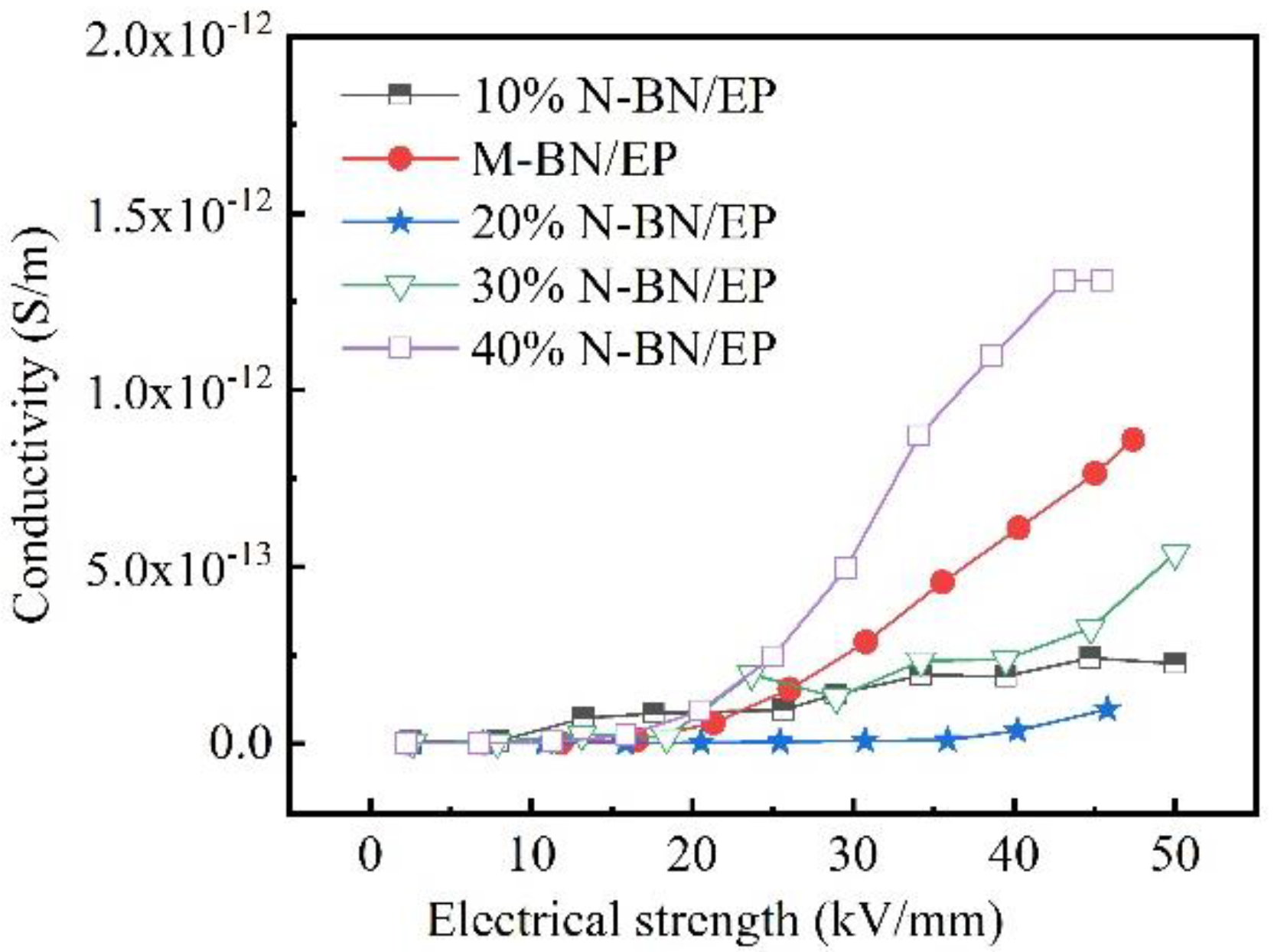

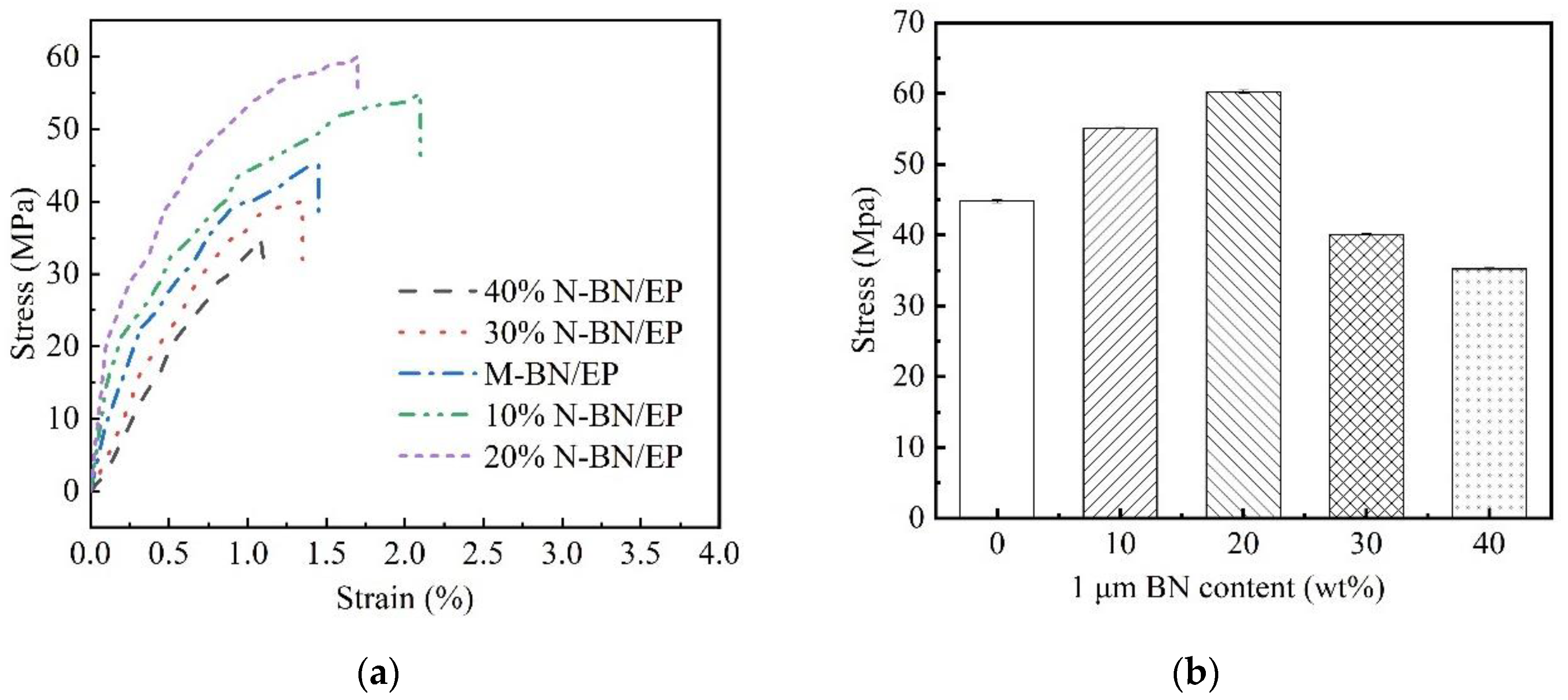
| EP Composite | α | β |
|---|---|---|
| M-BN/EP | 74.2 | 2.5 |
| 10% N-BN/EP | 76.5 | 0.5 |
| 20% N-BN/EP | 77.1 | 1.0 |
| 30% N-BN/EP | 73.6 | 0.81 |
| 40% N-BN/EP | 73.2 | 1.5 |
Publisher’s Note: MDPI stays neutral with regard to jurisdictional claims in published maps and institutional affiliations. |
© 2022 by the authors. Licensee MDPI, Basel, Switzerland. This article is an open access article distributed under the terms and conditions of the Creative Commons Attribution (CC BY) license (https://creativecommons.org/licenses/by/4.0/).
Share and Cite
Wang, S.; Cao, K.; Wang, G.; Chen, M.; Wang, H. Preparation and Properties of Epoxy Composites with Multi-Scale BN Sheets. Appl. Sci. 2022, 12, 6171. https://doi.org/10.3390/app12126171
Wang S, Cao K, Wang G, Chen M, Wang H. Preparation and Properties of Epoxy Composites with Multi-Scale BN Sheets. Applied Sciences. 2022; 12(12):6171. https://doi.org/10.3390/app12126171
Chicago/Turabian StyleWang, Sijiao, Kaiming Cao, Guanwei Wang, Mengmeng Chen, and Hongxi Wang. 2022. "Preparation and Properties of Epoxy Composites with Multi-Scale BN Sheets" Applied Sciences 12, no. 12: 6171. https://doi.org/10.3390/app12126171
APA StyleWang, S., Cao, K., Wang, G., Chen, M., & Wang, H. (2022). Preparation and Properties of Epoxy Composites with Multi-Scale BN Sheets. Applied Sciences, 12(12), 6171. https://doi.org/10.3390/app12126171





